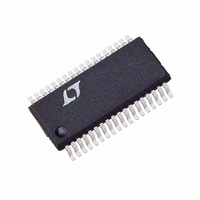LTC3719EG Linear Technology, LTC3719EG Datasheet - Page 13

LTC3719EG
Manufacturer Part Number
LTC3719EG
Description
IC SW REG SYNC STEP-DOWN 36-SSOP
Manufacturer
Linear Technology
Datasheet
1.LTC3719EG.pdf
(32 pages)
Specifications of LTC3719EG
Applications
Controller, AMD Opteron™
Voltage - Input
4 ~ 36 V
Number Of Outputs
1
Voltage - Output
0.8 ~ 1.55 V
Operating Temperature
-40°C ~ 85°C
Mounting Type
Surface Mount
Package / Case
36-SSOP
Lead Free Status / RoHS Status
Contains lead / RoHS non-compliant
Available stocks
Company
Part Number
Manufacturer
Quantity
Price
Part Number:
LTC3719EG
Manufacturer:
LINEAR/凌特
Quantity:
20 000
Part Number:
LTC3719EG#PBF
Manufacturer:
LT/凌特
Quantity:
20 000
Company:
Part Number:
LTC3719EG#TR
Manufacturer:
LT
Quantity:
2 300
Part Number:
LTC3719EG#TRPBF
Manufacturer:
LINEAR/凌特
Quantity:
20 000
APPLICATIO S I FOR ATIO
The basic LTC3719 application circuit is shown in
Figure 1 on the first page. External component selection
begins with the selection of the inductors based on ripple
current requirements and continues with the current
sensing resistors using the calculated peak inductor
current and/or maximum current limit. Next, the power
MOSFETs, D1 and D2 are selected. The operating fre-
quency and the inductor are chosen based mainly on the
amount of ripple current. Finally, C
ability to handle the input ripple current (that PolyPhase
operation minimizes) and C
ESR to meet the output ripple voltage and load step
specifications (also minimized with PolyPhase). Current
mode architecture provides inherent current sharing be-
tween output stages. The circuit shown in Figure 1 can be
configured for operation up to an input voltage of 28V
(limited by the external MOSFETs). Current mode control
allows the ability to connect the two output stages to two
different input power supply rails. A heavy output load can
take some power from each input supply according to the
selection of the R
R
R
current. The LTC3719 current comparator has a maxi-
mum threshold of 75mV/R
mode range of SGND to 1.1(INTV
parator threshold sets the peak inductor current, yielding
a maximum average output current I
value less half the peak-to-peak ripple current, I
Assuming a common input power source for each output
stage and allowing a margin for variations in the
LTC3719 and external component values yields:
where N = 2 for 2 phase. For more than 2 phase use the
LTC1629-6 plus the LTC3719.
Operating Frequency
The LTC3719 uses a constant frequency, phase-lockable
architecture with the frequency determined by an internal
capacitor. This capacitor is charged by a fixed current
SENSE
SENSE1,2
R
SENSE
Selection For Output Current
are chosen based on the required peak output
N
50
I
MAX
SENSE
mV
U
resistors.
U
OUT
SENSE
is chosen with low enough
and an input common
CC
W
MAX
IN
). The current com-
is selected for its
equal to the peak
U
L
.
TM
PolyPhase is a registered trademark of Linear Technology Corporation.
plus an additional current which is proportional to the
voltage applied to the PLLFLTR pin. Refer to Phase-
Locked Loop and Frequency Synchronization for addi-
tional information.
A graph for the voltage applied to the PLLFLTR pin vs
frequency is given in Figure 2. As the operating frequency
is increased the gate charge losses will be higher, reducing
efficiency (see Efficiency Considerations). The maximum
switching frequency is approximately 310kHz.
Inductor Value Calculation and Output Ripple Current
The operating frequency and inductor selection are inter-
related in that higher operating frequencies allow the use
of smaller inductor and capacitor values. So why would
anyone ever choose to operate at lower frequencies with
larger components? The answer is efficiency. A higher
frequency generally results in lower efficiency because
MOSFET gate charge and transition losses increase
directly with frequency. In addition to this basic tradeoff,
the effect of inductor value on ripple current and low
current operation must also be considered. The PolyPhase
approach reduces both input and output ripple currents
while optimizing individual output stages to run at a lower
fundamental frequency, enhancing efficiency.
The inductor value has a direct effect on ripple current.
The inductor ripple current I
decreases with higher inductance or frequency and
increases with higher V
Figure 2. Operating Frequency vs V
2.5
2.0
1.5
1.0
0.5
0
120
OPERATING FREQUENCY (kHz)
170
IN
or V
220
L
OUT
per individual section, N,
:
270
PLLFLTR
LTC3719
3719 F02
320
sn3719 3719fs
13













